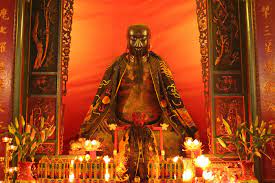

TYPE: Astral god of war
ORIGIN: Taoist (Chinese)
KNOWN PERIOD OF WORSHIP: Probably from the Shang Dynasty (second millennium BCE) until present.
SYNONYMS: Hsuan T'ien Shang Ti; Shang-ti yeh (Taiwanese)
CENTER(S) OF CULT: Palace of Jade Vacuity on Cheung Chau Island
ART REFERENCES: Paintings and Sculptures
LITERARY SOURCES: various philosophical and religious texts, mostly inadequately researched and untranslated.
INFORMATION: As first general of heaven's armies, he is regarded as a guardian of the Chinese state comparable to Kuan Ti, but older in mythology and identified with the north. According to tradition he lived circa 2000 BCE and was deified during the war between the Chou and Shang dynasties. During his mortal lifetime he was allegedly responsible for the introduction of flood control and land drainage systems. Alternatively, he spent much of his life seeking a Buddhist-style perfection on the mountain of Wu T'ang Shan. He was taken to heaven to assist the established pantheon in defeating two traditional monsters, the tortoise and the snake. Pak Tai hurled them into a deep chasm and, on his return, was made first lord of heaven.
He is also titled emperor of the north. His full title, Hsuan T'ien Shang Ti, means superior ruler of the dark heaven, as distinct from the moving and more accessible heaven ruled by the god Huang Ti. Before his deification, the north of China was believed to be ruled by the tortoise, the so-called dark warrior.
Pak Tai is also closely connected with death and fertility. He is a guardian of society who may descend from heaven to restore stability in times of unrest or destruction. On the Island of Cheung Chau he is believed to have been responsible for ending a plague that afflicted the islanders at the end of the nineteenth century.